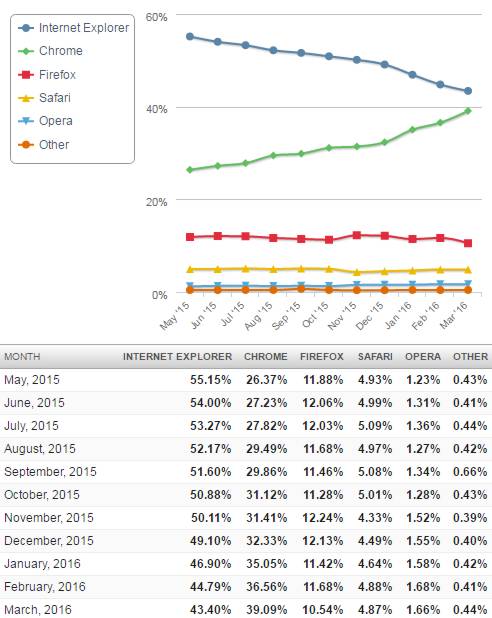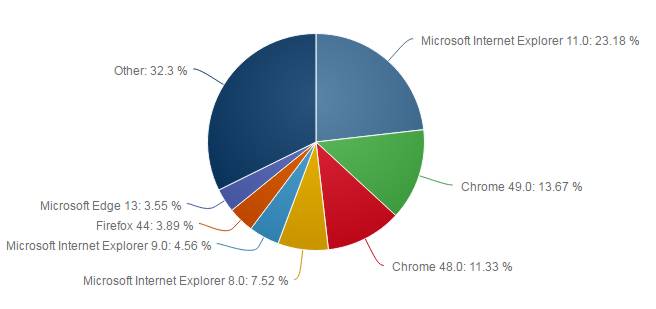| Is Chrome Most Prevalent Browser? |
| Written by Janet Swift | |||
| Wednesday, 06 April 2016 | |||
|
Google Chrome has been steadily increasing its browser market share while Microsoft has been losing its. If the trend continues Chrome could soon become the top desktop browser.
This is a snapshot of what has happened over the past eleven months according to global statistics gathered by Net Applications:
In this chart Internet Explorer aggregates different versions of IE and Edge, Microsoft's latest browser. It has been losing around a percentage point per month with the rate of decline getting steeper since the turn of this year. Turn the clock back to May 2015, where the above chart starts and Internet Explorer looked pretty unassailable. Its desktop browser share had dipped by less than 3% over the previous 12 months. However look closer and you'll see that while the Internet Explorer share had remained steady, even putting on a percentage point, between May and December 2014, the decline set in at the very beginning of 2015. You can see the corresponding chart here. Looking at the latest chart Chrome's rate of increase has accelerated in the past few months - which is why in a couple of months the green line on the chart could have crossed the blue one. If you refer back to last year's chart you'll notice that the trend of it taking share from Internet Explorer does indeed date from the beginning of 2015. Prior to that Chrome's increase was balanced by a decrease in Firefox's share and to a certain extent that has continued but Firefox, with an 11% share is now relegated to a poor third place as a desktop browser. This is even more evident if you look at the NetMarketShare browser versions pie chart where the current version, Firefox 44 has a share of less than 4%, other versions of Firefox are lumped into the large Other slice of the pie.
This pie chart shows that IE 11 is currently the desktop browser that is most frequently used with 23.2%. If you put together the two latest versions of Chrome, both of which can be considered "current" then Chrome has a 25.0%. You might expect Edge to have a substantial slice of the pie since it is Microsoft's other support browser - remember Microsoft stopped supporting IE 8, 9 and 10 in January 2015 - just when the downward trend for Internet Explorer started. However, Edge 13 has an even smaller slice than Firefox 44 and adding in Edge 12 still gives Edge a smaller slice than IE 9.
OK Edge is still under development, but it is the default browser on Windows 10 and Microsoft tries hard to persuade users to stick with it. Given that Microsoft isn't planning to maintain IE 11 beyond the lifetime of Windows 10 in 2020 it really does not to strengthen Edge in order to have any future for its browsers. On the other hand what the pie chart does show is that stopping support for IE 8, 9, and to a less extent 10 hasn't stopped people using them. Without them Chrome would already have overtaken Internet Explorer in the Desktop Browser Charts Trend.
More InformationRelated ArticlesChrome Makes More Gains Firefox Continues To Decline Microsoft Stops Supporting IE 8, 9 and 10 To be informed about new articles on I Programmer, sign up for our weekly newsletter, subscribe to the RSS feed and follow us on, Twitter, Facebook, Google+ or Linkedin.
Comments
or email your comment to: comments@i-programmer.info |
|||
| Last Updated ( Wednesday, 06 April 2016 ) |




